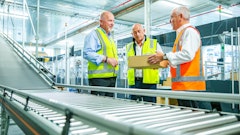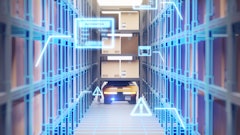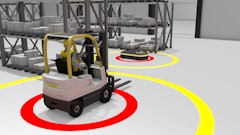
Operating a massive warehouse or distribution center is an expensive proposition, and one of the greatest expenses is the energy it takes to operate these facilities. The U.S. Energy Information Administration (EIA) estimates that U.S. warehouses spend an average of $0.70 per square foot on energy, with half of that amount spent on natural gas and the other half on electricity.
Today, operators of these massive facilities are increasingly turning to solar power to control their energy consumption. Food Logistics recently caught up with Patrick Smith, vice president of IGS Solar, to take a closer look at what to consider when implementing solar technology.
FL: What are the challenges of operating a sustainable warehouse/distribution center?
Smith: Energy costs tend to be volatile, making it difficult to budget for this expense. When you consider that energy costs often comprise 15 percent of a warehouse/DC’s total operating budget, finding ways to contain this expenditure can be very valuable.
Similarly, another challenge is the limitation on securing a very long-term position on a typical energy contract that lasts longer than three years. Solar can provide facility managers and owners with even greater future price certainty.
Further, sustainability within the warehouse/DC is not always top of mind for corporate leaders, who are measured against operational efficiencies and face pressures for bottom-line results. Typical corporate sustainability initiatives are capital-intensive and often assessed against return on investment (ROI) calculations. For example, with a facility LED retrofit, the savings generated through the efficiency program are used to offset the initial costs over a period of time, which can range from several months to several years.
Though increasing competition tends to prioritize cost-saving measures over sustainability projects, there are options to do both. Leading companies and major retailers like Target, Walmart, and IKEA have already demonstrated a focus on sustainability by installing solar systems. There is plenty of opportunity in the warehouse/DC market, too, with many larger owners making solar commitments, as well. It’s also important to note that there is an increasing percentage of individuals seeking to buy from and work for sustainable companies.
By implementing a solar program using a third-party ownership model such as a lease or Power Purchase Agreement (PPA), there is no initial capital investment required. These off-balance sheet contracts can equate to immediate savings to the bottom line.
FL: Why consider solar power in the warehouse/distribution center?
Smith: This is really a great time to go solar. Outside of the economic benefits, having a solar energy system installed at your facility positions your business as a renewable energy leader. Employees and corporate partners increasingly want to work with companies that have a robust sustainability program and results to support it. What better way to demonstrate your commitment than with a roof full of solar panels?
There are a lot of options to consider, as the solar market continues to grow at a record pace. The Department of Energy’s 2017 Energy and Employment report showed that solar now employs more than coal, oil, and gas industries combined. This is due in part to a stronger corporate commitment to sustainability, and shows that solar is an increasingly viable energy option across the country. Given the growth and widespread nature of solar, there are lot more options to consider. I’d encourage any business looking to increase their sustainability commitment to speak with a trusted energy provider to understand what’s available to them. I think they’ll be pleased with the opportunities they have for their organizations.
FL: How can companies finance solar energy?
Smith: Companies really have three main options when it comes to financing solar:
- Purchase the system outright using cash or a loan, which requires significant capital deployment and is assessed using an ROI calculation. This option equates to the greatest per-kWh savings, but requires the most upfront costs.
- Lease the system through long-term fixed monthly payments. In some markets, a lease is the only third-party option available based on regulatory limitations for system ownership.
- Secure third-party system ownership through a Power Purchase Agreement (PPA). Customers choosing this option only pay for the power that’s produced by the system on a monthly basis, often at a rate below current energy costs.
FL: What is the cost of a solar installation?
Smith: This really varies based on the customer, market, location, building size, roof type, utility, state incentives, etc. But in general, for a system installed on a 100,000-square-foot roof, you could expect to pay between $1.5 million and $3 million.
However, with a lease or PPA model, where the system is owned by a third party, there is no upfront cost to the customer for the solar array itself or for ongoing maintenance. This is why a majority of commercial solar systems are structured under a third-party model. In fact, customers choosing this option are typically saving 10 to 20 percent on their energy costs without any capital outlay or responsibilities of ownership.
FL: How can IGS Solar provide solar energy to offset these energy costs?
Smith: IGS Solar primarily offers a PPA because we find it to be the most transparent and simplest option for customers. Our model is based on IGS Solar installing, owning, and operating the solar assets long-term on behalf of our customers. The solar system produces power onsite, which is consumed directly by our customers. Our customers benefit by paying lower energy prices through a long-term fixed rate within the PPA. This serves as a long-term energy hedge against volatile electricity pricing over time.
Solar is not an energy-efficiency product, and therefore isn’t designed to reduce energy consumption. However, it does defray traditional utility costs by offsetting them with renewable energy. It also helps companies to support corporate sustainability without the expense, maintenance, or uncertainty associated with owning and operating a system themselves.
FL: What do companies need to consider as they add solar energy capabilities?
Smith: Given the long-term nature of these projects, (and in the unique case of cash/loan purchases—high capital costs) there are several important considerations as companies navigate their solar options. Here are some things to ask yourself if you’re considering solar:
- Do you own or lease your property? A solar system’s useful life is generally up to 30 years and third-party contracts typically last 15-25 years.
- Is your roof’s condition or land suitable for a solar installation? Your solar provider or a local engineer can assess this for you.
- What are your renewable/energy efficiency goals? Can solar help you to achieve them?
- Are you planning any other energy efficiency projects that would lower your power demand? Depending on the individual facility, it is often recommended that these are done in advance of a major solar installation.
- Do you have a corporate champion that could help take your solar project from idea to reality? Projects can often take 12-18 months from initial concept to full deployment.
- Does your organization have the financial and human resource capacity to internally manage the development and ownership of a solar program?
If you do find solar is a fit for your facility, there really is no better time to consider it, given the dramatic decline in the cost of this technology, favorable federal tax incentives, and many states with solar programs designed to spur development. Of course, these are subject to market conditions and regulatory changes, so the time to act is now.”
FL: Is a solar installation possible at every warehouse or DC? Why or why not?
Smith: While most have sufficient power usage and square footage to qualify for solar, we also need to consider any property limitations and economic benefits that a solar project will drive. Economic factors can include state incentives, power rates, geographic locations, and weather conditions; while property considerations can include snow loading, structural integrity, and roof age, and/or land availability. Therefore, it is unlikely that every warehouse/DC would benefit from a solar installation.
Having a discussion with an experienced solar provider is helpful because they can assess your company’s facilities and determine what would make the most sense for your business.



























